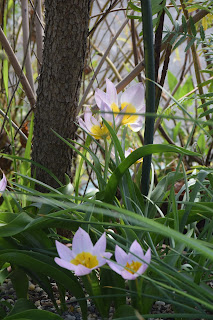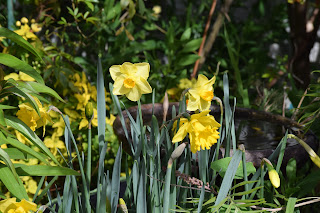Even though spring isn't officially here until March 22nd, I always feel that the beginning is heralded by the arrival of daylight savings time. That extra hour of daylight plus our usually mild weather around its date makes it seem like a preview of spring to come.
There's still a lot going on in my garden. Here's a look.
Sparaxis (Harlequin flower) is one of the earliest bulbs to bloom. Lots of different colors too.
Here is my Walkway Bed. As you can see, it's densely filled in now, with a variety of spring blooming bulbs and various perennials.
CA natives need not be boring. Here's a lovely, long blooming native Verbena (V. lilacina de la Mina). It's little puffs of purple last a long time and attract bees and butterflies.
Here's an unusual honeysuckle. It's Lonicera tatarica 'Arnold Red.' The flowers are different and there's no fragrance but it's charming nonetheless.
My million bells returned in this decorative pot, along with a fabulous lily called Triumphator.
There's nothing prettier than the native Baby Blue Eyes (Nemophila menziesii).
Though this shot is a bit dark, I wanted to share a photo of the early blooming species tulip T. saxatilis.
Cerinthe major is one of the easiest plants to grow and it self seeds vigorously. Here are flowers on one that did self seed in my walkway bed.
Here's my multi-colored Erysimum, with a different Sparaxis nearby.
California native Mimulus seem to bloom on their own schedule. Here, my M. Jelly Bean Gold has put out its first flowers of the year.
Another native is the charming Claytonia sibirica. Apart from the sweet flowers, the leaves are edible.
I think there must be a botanical term for those plants that produce flowers from the stems, not at the tips of branches. Here's one - Calothamnus villosus. Though the fan-shaped flowers look delicate, they;re actually stiff and almost rubbery.
Bulbine Yellow. Once I got this bulbous plant in the ground, it really took off. It has tons of flower spikes.
Freesia Red + Ipheions. What is there not to love about Freesias. Easy to grow, colorful and oh so fragrant. And the pale blue, star-shaped flowers are Ipheions. They complement each other nicely.
Phlomis fruticans. This sage relative is a reliable bloomer and very popular with bees.
March is daffodils season and here are a couple that are part of a doubles mix.
Oxalis teneriensis. This 'friendly' oxalis is a winter bloomer.
Though the shot is a bit on the dark side, this is my Grevillea victoriae in bloom.
Readers of this blog know that I'm infatuated with dwarf conifers. Here is a shot of my original dwarf conifer bed. To my delight, I was able to use photos of my dwarf conifer beds in a piece on this topic for the Friends of Regional Parks Botanic Garden eNewsletter in January.
My yellow Banksia rose went crazy on the blooming this spring.
Dutch iris 'Mystic Beauty.' This is one of my favorite Dutch iris varieties.
Daffodil Congress. This is a new daffodil variety this year.
Many plants are undergoing classification changes and this pretty little bulb, formerly known as Homeria collina, is now classified as Moraea collina. No matter the name, its delicate flowers are ever so pretty.
Epiphyllum. My red-flowering Epiphyllum is beginning to open its first flower of the year. This is the third year in a row that it has bloomed. A good sign.
This Sedum species has been in bloom for some time. Sweet!
Erica speciosa. This heather seems to bloom when it feels in the mood. Fortunately for me, that's pretty often.



























No comments:
Post a Comment